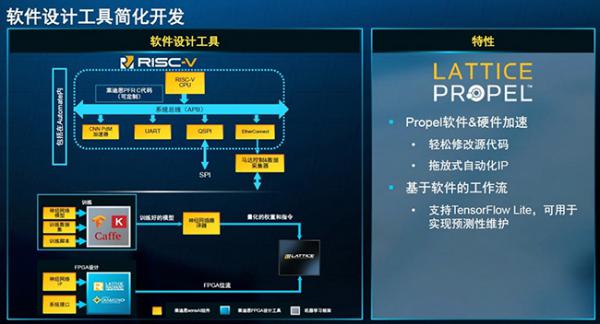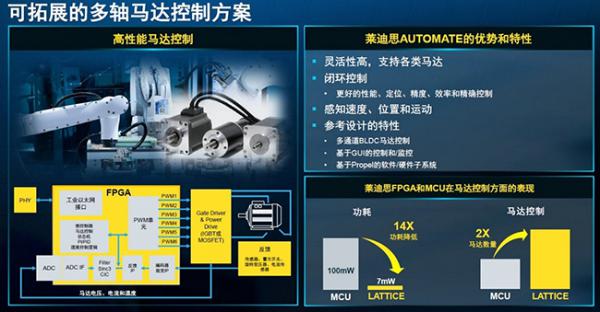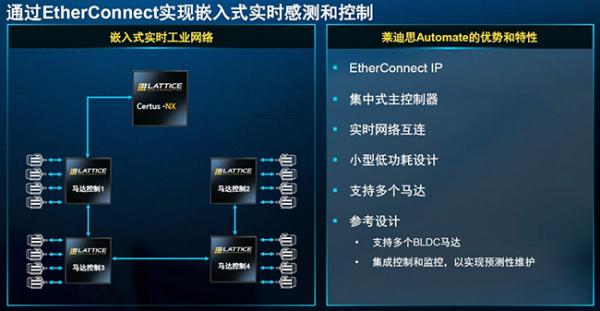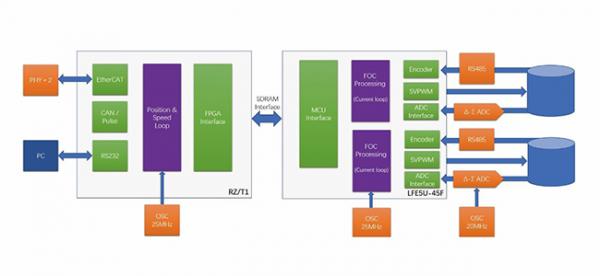“Following the launch of sensAI for low-power network edge AI in 2018, Lattice semiconductor will announce mVision 1.0 and Sentry 1.0 for low-power embedded vision and root of trust recovery for network protection in 2020, and their subsequent upgrades After versions mVision 2.0 and Sentry 2.0, the Automate solution collection for intelligent industrial systems has also been officially launched.
“
Following the launch of sensAI for low-power network edge AI in 2018, Lattice Semiconductor will announce mVision 1.0 and Sentry 1.0 for low-power embedded vision and root of trust recovery for network protection in 2020, and their subsequent upgrades After versions mVision 2.0 and Sentry 2.0, the Automate solution collection for intelligent industrial systems has also been officially launched.

What does Automate bring?
Similar to the architecture of sensAI, mVision and Sentry solutions, Automate’s underlying hardware platform is based on Certus-NX motor control development board and MachXO3D-based hardware security development board, on top of which is a series of IP cores (Ether-Connect, CNN processing Unit, PDM data collector), software tools (RADIANT, DIAMOND, Propel, RISC-V + hardware co-processing), reference design and demonstration and custom design services, together constitute a complete Automate solution.

As a low-power general-purpose FPGA, Certus-NX has an industry-leading number of I/Os and high-speed interfaces in a small form factor package—while the package size is as small as 6x6mm, the IO density per square millimeter is up to twice that of similar FPGAs; 1.5 Gbps differential I/O is up to 70% faster than comparable FPGAs, in addition to supporting 5Gbps PCIe, 1.25Gbps SGMII (GigE) and 1066Mbps DDR3 memory interfaces. Thanks to the 28nm FD-SOI process, the Lattice Nexus technology platform can deliver up to 4x lower power consumption and up to 100x lower Soft Error Rate (SER) than comparable FPGAs.
In the reference design and demonstration layer, Automate includes multi-axis motor control, predictive maintenance, real-time industrial network, hardware security and other aspects, which is convenient for rapid development of common industrial applications:
l Scalable Motor Control Solutions – Accelerates the development of flexible motor control systems, including GUI-based user interface tools for system monitoring and control.
l Predictive Maintenance – Minimize downtime by monitoring multiple motors in the system.
l Embedded real-time network – use Lattice Nexus FPGA as the central controller to implement a scalable sensing and control system for a variety of devices.
l Network Protection Recovery – Implement hardware root of trust to detect, protect and recover from firmware-based attacks in real time.
l Easy-to-use software design methodology – Automate supports Lattice Propel™, an embedded RISC-V processor that simplifies the development of industrial automation systems through software and hardware co-processing.
The software update is similar to the previous scheme. In addition to supporting the easy-to-use Lattice Radiant and Diamond design tools, Automate supports the use of RISC-V soft CPUs through the Lattice Propel design environment. This state-of-the-art graphical user interface (GUI)-based design tool can use drag-and-drop to quickly place and configure RISC-V processor-based designs. The latest version of the Propel design tool supports the new industrial IP cores included in Automate (Ether-Connect, CNN processing unit and PDM data collector).
In addition to simplifying system construction by dragging and dropping, developers can also mount the required functional IP modules on the Lattice RISC-V CPU core, and then build the system through a visual connection, and edit and execute it through a C code editor C code, which simplifies the development process. This reduces the need for FPGA professional background knowledge in one fell swoop, and developers can develop solutions even if they have no relevant professional background.

Automate application example
According to data from market research firm Fortune Business Insights, by 2027, the global industrial automation market is expected to reach $326.14 billion. The report of Allied Market Research pointed out that from 2020 to 2027, the global robot market will increase rapidly at a compound annual growth rate of 13.5%. Therefore, Automate’s application focus will focus on five areas: motor control, predictive maintenance, real-time network interconnection, functional safety, and network recovery protection to meet the requirements of next-generation industrial automation systems for low power consumption, low latency, and precise predictability. , high stability, flexible interface and other key features.

l Scalable multi-axis motor control scheme
Many electric motors are usually deployed in industrial scenarios. Appropriate control systems can significantly improve the efficiency and operational life cycle of these motors, but such control systems often require high-speed and accurate sampling of the motor’s voltage and current waveforms. FPGAs are well suited for this task, as they can handle at least double the number of motors compared to microcontrollers, providing higher performance than microcontrollers while consuming very little power.
In the Lattice FPGA scalable multi-axis motor control scheme shown in the figure below, the FPGA is responsible for collecting the feedback information of the motor and controlling the motor by generating PWM waves. Due to the fast response speed, high flexibility, and better positioning, accuracy, efficiency and precise control of FPGA devices, it can not only support various types of motors, but also achieve better closed-loop control. Compared with MCU, Lattice FPGA can control twice as many motors as MCU, and the power consumption can be as low as 7mW, which is far less than 100mW of MCU.

l Predictable maintenance with AI function
When it comes to maintaining equipment such as motors, the traditional approach is passive or active maintenance. Reactive maintenance typically involves running a machine continuously until it fails, and then dispatching people to diagnose and fix the problem; proactive maintenance is essentially repairing a machine before it breaks, which is laudable, but also time-consuming and expensive. Predictive dimensions, by contrast, use artificial intelligence and machine learning to monitor how machines are performing, grasping trends and anomalies in machine dynamics, and providing “warnings” to maintenance teams before machines stop working. Interestingly, predictive maintenance can be achieved just by monitoring the voltage and current values of the motor without any additional sensors (thermal, vibration, audio sensors, etc.).
Therefore, combined with the sensAI solution, predictive maintenance with AI capabilities is also introduced into Automate. In simple terms, it is used to judge whether the motor is in a stable, metastable or unstable state through information such as good/bad waveform and high/low signal stability, which helps to give early warnings of motor performance degradation. Continuing the use of the motor is another major feature of this solution. In traditional applications, unpredictable maintenance requires a fixed period of time for detection and reuse after confirming that there are no problems. However, by introducing predictable AI functions, downtime including human intervention will be greatly reduced.

l Embedded real-time sensing and control via Ether-Connect
The Ether-Connect embedded real-time sensing and control system is a newly developed function that narrows the differences in synchronization cooperation between devices in the sub-microsecond level through devices and solutions, so as to better control the synchronization of multiple motors operating simultaneously. Take Ether-Connect IP as an example, it can take advantage of the low power consumption of the device to achieve real-time network interconnection, while using a centralized master controller to manage multiple BLDC motors. The specific number of supports depends on the minimum refresh rate of the entire system. Currently, 16 control boards can be connected in series, or even longer.

In addition to supporting the EtherConnect private protocol, this solution also supports other industrial standard protocols such as EtherCAT. The high-performance EtherCAT servo drive solution launched by Lattice, Renesas Electronics and CLP is the most representative. This solution adopts Renesas MPU+Lattice FPGA dual-chip architecture, supports EtherCAT bus technology and multi-axis applications, and has the following three core advantages:
Advantage 1: FPGA controls the current loop, high performance, high precision
In the traditional scheme, due to the complex algorithms of the position loop and the speed control loop, the calculation is slow, and the current loop control needs to be updated quickly in real time. It is difficult to take into account these two different algorithms in a single processor chip. The dual-chip architecture adopted by Renesas MPU+Lattice FPGA can put the current loop control in the FPGA for hardware acceleration, greatly reducing the delay, making the current loop faster and improving the accuracy. Not only that, but the FPGA can also offload the work of the processor, thereby improving overall performance.

Multi-axis servo system using FPGA hardware current loop and EtherCAT bus architecture to achieve real multi-axis real-time synchronization
Advantage 2: Single/multi-axis application at better cost
Compared with the common SoC and DSP solutions in the market, FPGA has more advantages in realizing multi-axis synchronous control, current loop control, PWM control and output, etc., and can realize multi-axis control at the optimal cost. For example, DSP usually only supports a single-axis motor system. If a dual/multi-axis motor system is to be implemented, an additional chip is required; SoC can implement 1-6 axes, but the cost is high. Lattice FPGA can be flexibly matched with different models, can realize 1-6 axis motor control, and has more advantages in cost;

Servo solution comparison: RZ/T1+Lattice FPGA vs SoC vs DSP
Advantage 3: Flexible with different configurations
Renesas RZ/T1 series chips are compatible with a full range of pins, and different models can be flexibly selected according to different functions/frequency.
l Hardware security reference design
Automate mainly uses the chip characteristics of XO3D to achieve hardware-level protection, so as to perform firmware protection before startup, during startup and during normal movement. At the same time, the firmware can also be verified, monitored and protected, and once the firmware is found to be attacked, it can be quickly restored to its original state.
MachXO3D is a secure FPGA that can implement hardware root of trust. It uses hardware root of trust and dual-boot features to enhance security control applications. The newly added immutable embedded security module provides hardware root of trust and pre-verified encryption functions such as ECDSA , ECIES, AES, SHA, HMAC, TRNG, unique secure ID and public/private key generation for enhanced control. At the same time, Lattice has upgraded the user flash memory to 2700kbit, and provides commercial grade, industrial grade and AEC-Q100 compliant automotive grade products.
Conclusion:
The Automate solution collection implements Lattice’s product layout idea of continuously creating an “application-based solution stack”, and includes all the resources that embedded system designers need to accelerate the development of industrial automation applications. The core goal is to use software tools , industrial IP cores, modular hardware development boards, and software programmable reference designs and demonstrations to provide designers of industrial automation systems with the tools needed to evaluate, develop, and deploy FPGA-based programmable industrial automation applications to accelerate factory automation product development process.
In fact, it is worth noting that the Lattice Automate solution collection is not limited to traditional factory applications, it is also applicable to a wide variety of deployment environments and tasks, including warehouse automation and smart building monitoring, management and control.
The Links: https://www.slw-ele.com/ltm08c351r.html“> LTM08C351R LM64K104

0 Comments for “Develop forging acceleration engine for intelligent industrial automation”